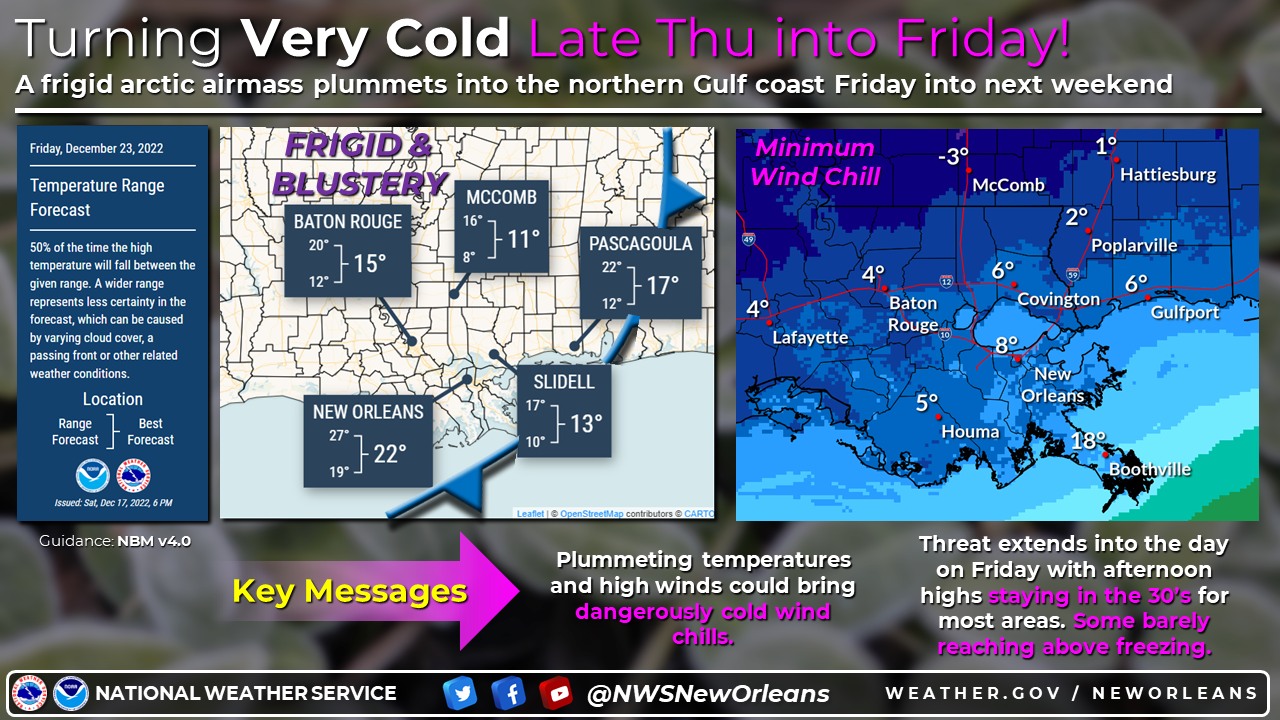
No sneaux for south LA – Winter Weather Statement from NWS
December 19, 2022
Terrebonne General Registered Dietitian Michelle Briceno Achieves Board Certification in Obesity and Weight Management
December 19, 2022You can avoid a frozen pipe crisis and all of the misery that comes with it – being without water while on a plumber’s long waiting list and thousands of dollars of damage to your walls, floors and furniture – by taking a few simple measures to protect your home.
According to Dr. Claudette Reichel, LSU AgCenter housing specialist, when a bitter cold front rolls in, be sure your home’s water pipes are protected.
“When water freezes, it expands,” Reichel says. “If ice forms in your home’s water pipes, it can shatter pipe seals or the pipes themselves, sending water pouring through your house.”
She said extra caution is needed for homes that are to be vacant for an extended period.
“To winterize a house that will be vacant in frigid temperatures without heat, it is recommended to drain pipes,” Reichel said. “For hard-freeze conditions, many recommend adding nontoxic antifreeze (RV or boat antifreeze – NOT auto antifreeze) in the toilet bowls (about 1/3 gallon) and the p-traps of sinks and drains (about 2 cups) – or having a professional plumber drain and winterize the entire system.”
Reichel gives these tips to avoid frozen pipe problems:
Before The Freeze
– Insulate all exposed outdoor and attic pipes with weather-resistant material. Insulating-foam tubing designed for pipes is easy to install and inexpensive. Make sure all surfaces of the pipe are covered.
– If an extended and deep freeze is expected, insulation alone may not be sufficient. Consider installing electric heat tape or cable with a built-in thermostat. Be sure the heat tape bears an Underwriters’ Laboratories (UL) seal and is in good condition. Do not overlap the tape when wrapping it around a pipe.
– Use insulating faucet covers, or wrap rags, paper, trash bags or plastic foam around outdoor faucets. Installing pressure-relief valves on outdoor faucets also helps prevent bursting of pipes that freeze.
– Temporarily cover any vents around your home’s foundation.
– Bring water hoses indoors.
– Open the cabinets under the sinks in your kitchen and bathrooms to allow heated indoor air to circulate around water pipes.
– If you normally set back your thermostat at night or when away from home, change the setting to keep some heat on until the severe freeze is over.
– Insulate your outdoor water meter box and be sure its lid is on tight.
– Protect outdoor electrical pumps.
– If you have a swimming pool, either drain the circulation system or keep the pump motor running. (Run the pump motor only in a short freeze. Running the motor for long periods could damage it.)
– If your home has exposed pipes and a severe freeze is expected, let faucets run at a slow trickle, but don’t run a big stream of water. Too many running faucets in an area can cause drops in community water pressure and problems for fire-fighting emergencies.
– If you plan to leave town, consider turning off your water at the shut-off valve while faucets are running to drain your pipes. (Make sure the faucets are turned off before you turn the shut-off valve back on.)
– If you drain your pipes, contact your electric or gas utility for instructions on protecting your water heater.
– Finally, be sure everyone in your household knows where the main water shut-off valve is and check it to make sure it isn’t stuck.
If Your Pipes Freeze
– Turn off your water at the main shut-off valve.
– Call a plumber for help.
– Don’t use a blowtorch or other flame source, heat lamps or electrical appliances to thaw frozen pipes. Intense heat could cause steam pressure build-up and an explosion. Flames can ignite combustibles. Leaking water from thawing pipes could cause a short and you could be electrocuted.
– If you try to thaw your own pipes, apply heat slowly and move it toward the coldest spot on the pipe. Don’t heat the middle of a frozen section first because that could cause pressure to build between frozen sections. Never concentrate heat in one spot — cracking ice can shatter a pipe. A relatively safe and effective method is to wrap towels around the frozen section of pipe and pour hot water over them.
If You Have a Loss
– Contact your insurance agent or company promptly.
– Review your coverage. Homeowners’ and renters’ policies pay for property repair. In addition, they may pay for debris removal and for temporary additional living expenses if you have to move.
– If you can’t find your policy, ask your agent or company for a copy.
– Homeowner policies may require you to make temporary repairs to protect your property from further damage.
– Keep all receipts and damaged property for the adjuster to inspect. If possible, take photos or videos of the damage before making repairs.
– Don’t make permanent repairs. An insurance company may deny a claim if you make permanent repairs before an adjuster inspects the damage.
Reichel advises that some homeowner’s policies may not cover loss caused by freezing pipes while your house is unoccupied unless you have used reasonable care to maintain heat in the building, shut off the water supply or drain plumbing, heating and air conditioning systems of water.
For more information on how to cope during cold weather visit the LSU AgCenter Web site at www.lsuagcenter.com.











